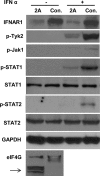Enterovirus 71 disrupts interferon signaling by reducing the level of interferon receptor 1
- PMID: 22258259
- PMCID: PMC3302529
- DOI: 10.1128/JVI.06687-11
Enterovirus 71 disrupts interferon signaling by reducing the level of interferon receptor 1
Abstract
The recent outbreak of enterovirus 71 (EV71) infected millions of children and caused over 1,000 deaths. To date, neither an effective vaccine nor antiviral treatment is available for EV71 infection. Interferons (IFNs) have been successfully applied to treat patients with hepatitis B and C viral infections for decades but have failed to treat EV71 infections. Here, we provide the evidence that EV71 antagonizes type I IFN signaling by reducing the level of interferon receptor 1 (IFNAR1). We show that the host cells could sense EV71 infection and stimulate IFN-β production. However, the induction of downstream IFN-stimulated genes is inhibited by EV71. Also, only a slight interferon response and antiviral effects could be detected in cells treated with recombinant type I IFNs after EV71 infection. Further studies reveal that EV71 blocks the IFN-mediated phosphorylation of STAT1, STAT2, Jak1, and Tyk2 by reducing IFNAR1. Finally, we identified the 2A protease encoded by EV71 as an antagonist of IFNs and show that the protease activity is required for reducing IFNAR1 levels. Taken together, our study for the first time uncovers a mechanism used by EV71 to antagonize type I IFN signaling and provides new targets for future antiviral strategies.
Figures







Similar articles
-
Enterovirus 71 inhibits cellular type I interferon signaling by downregulating JAK1 protein expression.Viral Immunol. 2014 Aug;27(6):267-76. doi: 10.1089/vim.2013.0127. Epub 2014 Jun 6. Viral Immunol. 2014. PMID: 24905060
-
Enterovirus 71 suppresses interferon responses by blocking Janus kinase (JAK)/signal transducer and activator of transcription (STAT) signaling through inducing karyopherin-α1 degradation.J Biol Chem. 2017 Jun 16;292(24):10262-10274. doi: 10.1074/jbc.M116.745729. Epub 2017 Apr 28. J Biol Chem. 2017. PMID: 28455446 Free PMC article.
-
Essential Role of Enterovirus 2A Protease in Counteracting Stress Granule Formation and the Induction of Type I Interferon.J Virol. 2019 May 1;93(10):e00222-19. doi: 10.1128/JVI.00222-19. Print 2019 May 15. J Virol. 2019. PMID: 30867299 Free PMC article.
-
An update on enterovirus 71 infection and interferon type I response.Rev Med Virol. 2019 Jan;29(1):e2016. doi: 10.1002/rmv.2016. Epub 2018 Oct 30. Rev Med Virol. 2019. PMID: 30378208 Free PMC article. Review.
-
Antiviral and Inflammatory Cellular Signaling Associated with Enterovirus 71 Infection.Viruses. 2018 Mar 28;10(4):155. doi: 10.3390/v10040155. Viruses. 2018. PMID: 29597291 Free PMC article. Review.
Cited by
-
Transcriptomic assay of CD8+ T cells in treatment-naïve HIV, HCV-mono-infected and HIV/HCV-co-infected Chinese.PLoS One. 2012;7(9):e45200. doi: 10.1371/journal.pone.0045200. Epub 2012 Sep 13. PLoS One. 2012. PMID: 23028845 Free PMC article.
-
Innate Immunity Evasion by Enteroviruses Linked to Epidemic Hand-Foot-Mouth Disease.Front Microbiol. 2018 Oct 8;9:2422. doi: 10.3389/fmicb.2018.02422. eCollection 2018. Front Microbiol. 2018. PMID: 30349526 Free PMC article. Review.
-
3Cpro of foot-and-mouth disease virus antagonizes the interferon signaling pathway by blocking STAT1/STAT2 nuclear translocation.J Virol. 2014 May;88(9):4908-20. doi: 10.1128/JVI.03668-13. Epub 2014 Feb 19. J Virol. 2014. PMID: 24554650 Free PMC article.
-
Cerebrospinal fluid chemokine patterns in children with enterovirus 71-related encephalitis.Sci Rep. 2018 Jan 26;8(1):1658. doi: 10.1038/s41598-018-19988-6. Sci Rep. 2018. PMID: 29374213 Free PMC article.
-
Life-Threatening Enterovirus 71 Encephalitis in Unrelated Children with Autosomal Dominant TLR3 Deficiency.J Clin Immunol. 2022 Apr;42(3):606-617. doi: 10.1007/s10875-021-01170-9. Epub 2022 Jan 18. J Clin Immunol. 2022. PMID: 35040013
References
Publication types
MeSH terms
Substances
LinkOut - more resources
Full Text Sources
Other Literature Sources
Research Materials
Miscellaneous

